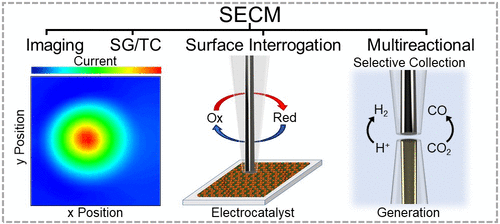当前位置:
X-MOL 学术
›
Ind. Eng. Chem. Res.
›
论文详情
Our official English website, www.x-mol.net, welcomes your feedback! (Note: you will need to create a separate account there.)
Characterizing Electrocatalysts with Scanning Electrochemical Microscopy
Industrial & Engineering Chemistry Research ( IF 4.2 ) Pub Date : 2018-05-23 , DOI: 10.1021/acs.iecr.8b00922 Dylan T. Jantz 1 , Kevin C. Leonard 1
Industrial & Engineering Chemistry Research ( IF 4.2 ) Pub Date : 2018-05-23 , DOI: 10.1021/acs.iecr.8b00922 Dylan T. Jantz 1 , Kevin C. Leonard 1
Affiliation

|
Scanning electrochemical microscopy (SECM) is a “non-contact” scanning probe technique capable of providing chemical and/or topographic information about surfaces immersed in a solution. It is a powerful in situ and operando tool for obtaining insights into electrocatalytic rates and mechanisms. Herein, examples are given on how SECM can be used to characterize (1) hydrogen oxidation reaction electrocatalysts for fuel-cell applications, (2) oxygen evolution reaction electrocatalysts for water splitting applications, and (3) electrochemical CO2-reducing catalysts. We also report a new operando method of SECM in which we can separate electrochemical reduction of CO2 to CO in aqueous media from parasitic hydrogen evolution as a function of applied potential. Understanding hydrogen evolution suppression is a major challenge in the intelligent design of CO2-reducing electrocatalysts. Via this multireactional SECM technique, we observed the optimal potential window for electrochemically reducing CO2 to CO with high selectivity. At potentials lower than this optimal window, CO2 reduction rates were small, but at potentials higher than this optimal window, water reduction to H2 dominated the electrochemical conversions. This observation is something that traditional voltammetry alone is not able to resolve. We anticipate that a wider adoption of SECM by the catalysis community will allow for the operando characterization of many types of catalysts, and holds the potential to provide unprecedented insights into the composition/activity and structure/activity relationships.
中文翻译:

扫描电化学显微镜表征电催化剂
扫描电化学显微镜(SECM)是一种“非接触式”扫描探针技术,能够提供有关浸入溶液中的表面的化学和/或形貌信息。它是一种功能强大的原位和操作工具,可用于深入了解电催化速率和机理。在此,给出了关于如何将SECM用于表征(1)用于燃料电池应用的氢氧化反应电催化剂,(2)用于水分解应用的氧析出反应电催化剂以及(3)电化学还原CO 2的催化剂的实例。我们还报告了一种新的SECM操作方法,其中我们可以将CO 2的电化学还原分离寄生氢的释放将水介质中的CO转化为CO的作用。在减少CO 2还原的电催化剂的智能设计中,了解氢的释放抑制是一项重大挑战。通过这种多反应性SECM技术,我们观察到了以高选择性将电化学方式将CO 2还原为CO的最佳电势窗口。在低于该最佳窗口的电势下,CO 2还原速率很小,但是在高于该最佳窗口的电势下,水还原成H 2占主导地位的电化学转化。这种观察是仅传统的伏安法无法解决的。我们预计,催化界将更广泛地采用SECM,这将使多种类型催化剂的操作表征,并具有提供对组成/活性和结构/活性关系的空前洞察力的潜力。
更新日期:2018-05-23
中文翻译:

扫描电化学显微镜表征电催化剂
扫描电化学显微镜(SECM)是一种“非接触式”扫描探针技术,能够提供有关浸入溶液中的表面的化学和/或形貌信息。它是一种功能强大的原位和操作工具,可用于深入了解电催化速率和机理。在此,给出了关于如何将SECM用于表征(1)用于燃料电池应用的氢氧化反应电催化剂,(2)用于水分解应用的氧析出反应电催化剂以及(3)电化学还原CO 2的催化剂的实例。我们还报告了一种新的SECM操作方法,其中我们可以将CO 2的电化学还原分离寄生氢的释放将水介质中的CO转化为CO的作用。在减少CO 2还原的电催化剂的智能设计中,了解氢的释放抑制是一项重大挑战。通过这种多反应性SECM技术,我们观察到了以高选择性将电化学方式将CO 2还原为CO的最佳电势窗口。在低于该最佳窗口的电势下,CO 2还原速率很小,但是在高于该最佳窗口的电势下,水还原成H 2占主导地位的电化学转化。这种观察是仅传统的伏安法无法解决的。我们预计,催化界将更广泛地采用SECM,这将使多种类型催化剂的操作表征,并具有提供对组成/活性和结构/活性关系的空前洞察力的潜力。



























 京公网安备 11010802027423号
京公网安备 11010802027423号